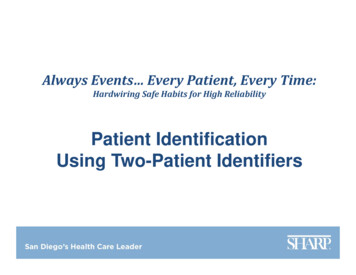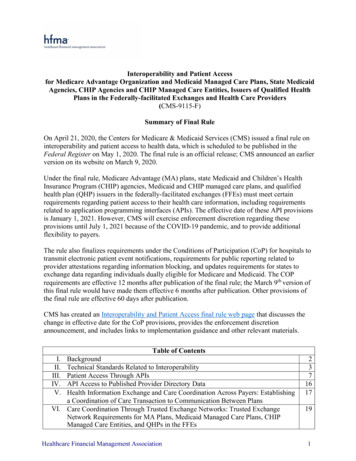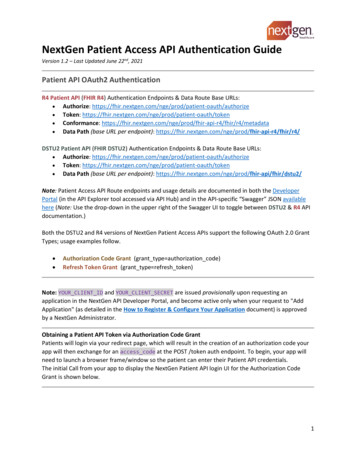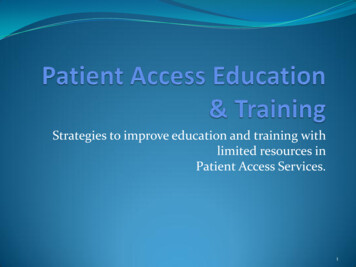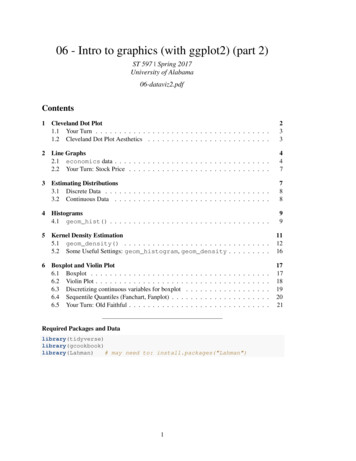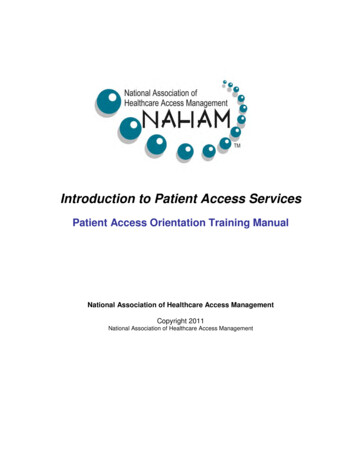
Transcription
Introduction to Patient Access ServicesPatient Access Orientation Training ManualNational Association of Healthcare Access ManagementCopyright 2011National Association of Healthcare Access Management
PREFACEDear Patient Access Services Managers and Staff Development Instructors:The National Association of Healthcare Access Managers (NAHAM) has developed thisresource for Healthcare Access Associates – your front-end staff. The information in thisuseful guide reviews a variety of topics essential in the orientation and development of frontend staff. It also can aid in the preparation of staff for the NAHAM Certified HealthcareAccess Associate (CHAA) Examination.This manual includes a course outline that may assist with course layout and preparationtime. There is also a brief quiz at the end of each section. An orientation checklist is includednear the end of the manual. You may want to modify this checklist to meet your needsduring the orientation of new employees.Introduction to Patient Access Services: Patient Access Orientation Training Manual 10/3/2011Since this manual is distributed nationwide to large and small facilities and it is used in boththe inpatient and outpatient arenas, some content is intended to be general in order toprovide you the opportunity to stress areas of particular importance to you as a manager orinstructor and to add information specific to your healthcare organization or work location.2Being the national organization representing your interests and needs, NAHAM desires tosupport your efforts to developing and retaining quality staff. Your comments andsuggestions regarding this training manual or any other issues are appreciated.Sincerely,NAHAM Education CommitteeThis is just a sample of the comprehensive information included in this valuable training resource.For more, order your copy today at:http://www.naham.org/pasmanual
ABOUT NAHAMThe National Association of Healthcare Access Management (NAHAM) is the only nationalprofessional organization dedicated to promoting excellence in the management of PatientAccess Services in all areas of the healthcare delivery system. Patient access servicesprofessionals provide quality services in registration and all of its support processes topatients, providers and payers into, through and out of their health care experience.NAHAM members have responsibilities for a wide spectrum of patient access services suchas, but not limited to, the following: Admissions, Registration, Financial Counseling, POScollections, Verification of benefits, Pre-certification, Physician Relations, Guest Relations,Information, Telecommunications, Scheduling, and other related areas, such as CaseManagement. Members may have evolving and specialized roles due to nursing and othertraining.Introduction to Patient Access Services: Patient Access Orientation Training Manual 10/3/2011Members work in: Hospitals, including those dedicated to clinical specialties such aspsychiatric, rehabilitation, children, women, and others, Nursing Homes, HMOs/PPOs,Freestanding Surgery Centers, Call Centers, Ambulatory Care Centers, Physician offices,Clinics, and Home Health Agencies.3Established in 1974, the Association serves as a central source of technical information onchanges and trends in healthcare that affect admitting/registration processes and patientaccess functions.With its national office in Washington, DC, NAHAM serves the national interests of itsmembers by advocating progressive changes in admitting/registration proceduresnationwide.NAHAM is the source for valuable education and support on issues impacting PatientAccess Services.This is just a sample of the comprehensive information included in this valuable training resource.For more, order your copy today at:http://www.naham.org/pasmanual
TABLE OF CONTENTSPreface/Intro to NAHAM . 2Section One: Revenue Cycle Basics . 5Section Two: Patient Access Services Overview . . . .8Section Three: Finance/Insurance. 33Section Four: Agencies and Government Regulations . 44Section Five: Customer Service .65Section Six: Performance Management . . .81Section Seven: Information Systems . .84Section Eight: NAHAM/CHAA . .87Introduction to Patient Access Services: Patient Access Orientation Training Manual 10/3/2011Answer Key - Sectional Quizzes . .924Glossary of Terms . .93Reference Sources . . 106This is just a sample of the comprehensive information included in this valuable training resource.For more, order your copy today at:http://www.naham.org/pasmanual
SECTION ONERevenue Cycle BasicsA basic understanding of the Revenue Cycle provides the Patient Access staff with theknowledge of the critical role they play in optimizing financial performance within theirorganization.Health care revenue cycle management consists of processes and methodologies thatorganizations put in place to ensure accurate and timely billing and payment of claims.Key employees from multiple departments are responsible for these processes. Those staffmembers include representation from Scheduling, Registration, Ancillary Services, CaseManagement, Health Information Management and Patient Accounts.Introduction to Patient Access Services: Patient Access Orientation Training Manual 10/3/2011The patient’s first contact is usually a scheduling or registration employee.5Best practices within the Patient Access Department, in addition to ensuring the integrity ofregistration data collected, include insurance and benefit verification, acquisition of referralsand pre-certifications for elective procedures, medical necessity validation and collection ofpatient financial liability.Likewise, the previously mentioned departments are responsible for charge capture, clinicaldocumentation, complete and accurate coding. Ideally, this completed financially securedaccount is ready to be billed by a team within the Patient Accounts Department. Typically,health care facilities hold bills for a period of four days prior to submission for payment andexpect payment from insurers within 45 days.A number of key processes affect revenue and cash and result in rejected claims or denialsfrom payers. They include incomplete insurance information, non-covered services andfailure to identify medically unnecessary services, late charges, coding delays anddiscrepancies and untimely billing.One of the most preventable reasons for claim rejections that delay collection of accountsreceivable is inadequate and incorrect information gathered at the time of registration.During each interview, the Patient Access staff member should validate and updatedemographic and insurance information ensuring a clean claim can be generated by thePatient Accounting Department. Rejected claims extend the time in which payment isreceived and require re-work within the accounting department.Health care revenue cycle management involves many strategies, including procedures thathospitals and clinics use to improve cash collections and meet goals. These strategies alsoinclude customer receivables valuation, underpayment recovery policies and transactionsinvolving federal government programs such as Medicare and Medicaid.This is just a sample of the comprehensive information included in this valuable training resource.For more, order your copy today at:http://www.naham.org/pasmanual
Introduction to Patient Access Services: Patient Access Orientation Training Manual 10/3/2011The Revenue Cycle6The Revenue Cycle includes all the events that occur from the time a patient enters ourhealthcare system to the time their bill is paid or otherwise resolved.With Patient Access at the beginning of the cycle, all other services depend on accurate andcomplete information from patient identification to entering insurance information toidentifying financial needs.This is just a sample of the comprehensive information included in this valuable training resource.For more, order your copy today at:http://www.naham.org/pasmanual
SECTION ONEQuiz1. Patient Access is at the of the revenue cycle.a. beginningb. middlec. end2. Health care revenue cycle management consists of processes and methodologiesthat organizations put in place to ensure accurate and timely billing and payment ofclaims.TrueFalseIntroduction to Patient Access Services: Patient Access Orientation Training Manual 10/3/20113. Other departments depend on the Patient Access Department for complete andaccurate data.7TrueFalse4. All of the following could be responsible for insurance denials except:a.b.c.d.inaccurate insurance dateincorrect patient identificationnon-covered servicesidentification of medically unnecessary tests in advance5. One of the most preventable reasons for claims rejection that delays collection ofaccounts receivables is:a. wait timesb. incorrect information gathered at the time of registrationc. failing to address a patients special needs at point of registrationThis is just a sample of the comprehensive information included in this valuable training resource.For more, order your copy today at:http://www.naham.org/pasmanual
SECTION TWOPatient Access Services OverviewPatient Access Services DepartmentPatient Access Services in a hospital setting encompasses many different roles andresponsibilities. It is one of the most important and concentrated areas in health care.Introduction to Patient Access Services: Patient Access Orientation Training Manual 10/3/2011It has been estimated that access staff is responsible for 80 cents of every dollar that comesinto the facility. They are responsible for the delivery of the critical components of therevenue cycle, as well as keeping the hospital compliant with the many regulatory agencies,maintaining patient safety through correct patient identification practices and responsible forproviding extraordinary customer service skills in situations that are often difficult.8The Patient Access Services model varies from facility to facility. Facility size influenceshow each Patient Access Services model and job roles are set up. In a large institution aPatient Access Service associate may be responsible for one type of patient registration orservice in one particular area, while in a smaller facility, the Patient Access Serviceassociate may be responsible for several areas and responsibilities. As an example, a 700bed hospital may have registrars in the ED that only registers patients into the EDdepartment, while in a rural 15 bed facility; the registrar may register ED patients, outpatients, in-patients and be responsible for bed placement and may serve as the hospital’sPBX operator.According to NAHAM, Patient Access general responsibilities include: Customer ServicePositive Identification of the patientProvide Information to the patient/familyHelp determine special needs of a patientPre-admission servicesScheduling of resources and servicesPre-certification of insuranceDetermine the correct level of careDistribute and/or obtain signatures on required documents:Rights, Notice of Privacy, Important Messages from Medicare, etc.Infection ControlCollection of accurate and complete patient informationPoint of Service collectionsSome of the departments within Patient Access Services include Registration: In-patient, Out-patient, ED, Surgery areas, clinicThis is just a sample of the comprehensive information included in this valuable training resource.For more, order your copy today at:http://www.naham.org/pasmanual
Pre-RegistrationSchedulingInsurance Verification and Pre-Certification/ReferralsInformation Desk functionsOperator Services(PBX)Financial CounselingPatient Accommodations or Bed ControlPre-Service ClearanceMPI (Master Person Index) search database servicesThe Patient Access Services departments have a critical role in the overall success of ahospital. Most of the services performed in Patient Access are at the beginning of theRevenue Cycle.Introduction to Patient Access Services: Patient Access Orientation Training Manual 10/3/2011The Revenue Cycle is a continuous process, beginning when a patient is identified asrequiring or requesting medical services and ending at the time payment is received and theaccount is closed.9By obtaining accurate information at the point of registration, such as patient demographicsand insurance or payment information, the services provided have a better chance of gettingpaid in a timely manner and without penalties, which positively affects the overall cash flowand revenue of the hospital. Incorrect registrations are a major financial burden on anyfacility, especially when employees must allocate time to work denials, re-bill, creditbalances, refunds, and reconcile incorrect reimbursement.In a perfect world, the patient presents for service, their insurance company has alreadyapproved their service and has agreed to pay for it, the registrar collects accurateinformation and signatures, the service is performed, charges are entered correctly, the HIMdepartment correctly codes the diagnosis and procedures, the bill is generated and sent tothe provider and without any delays, payment is made. This is called a “clean claim.”
Health care revenue cycle management consists of processes and methodologies that organizations put in place to ensure accurate and timely billing and payment of claims. True False 3. Other departments depend on the Patient Access Department for complete and accurate data. True False 4. All of the following could be responsible for insurance denials except : a. inaccurate insurance date b .

